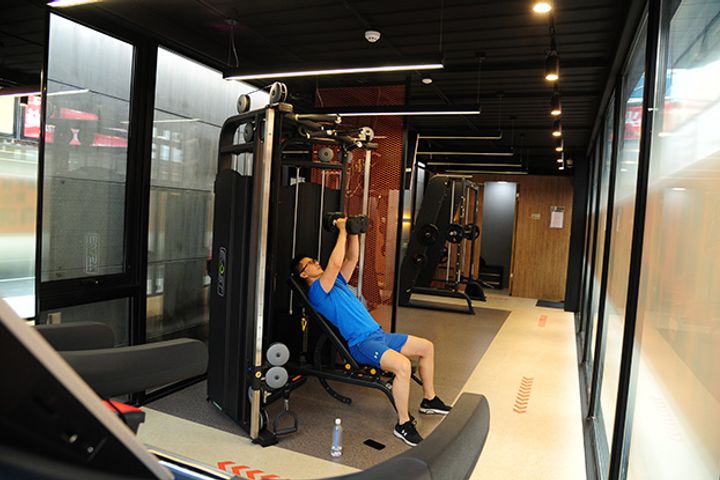 Clear Profit-Making Model for Shared Mini-Gyms Sector Yet to Emerge
Clear Profit-Making Model for Shared Mini-Gyms Sector Yet to Emerge(Yicai Global) Nov. 03 -- Companies offering shared-gym facilities in China's local residential communities have emerged in the market since April this year, and have attracted significant attention from the capital market. However, a clear model for producing profits is yet to be seen in the industry.
There are currently more than 20 shared mini-gym entities in operation in the domestic market, which aim to create a comfortable and safe fitness environment as close to local communities as possible.
In less than half a year, shared mini-gym providers have obtained more than CNY150 million in investment from investors including not only state-owned funds but also well-known investment institutions such as Matrix Partners China, Panda Capital and ChinaEquity Group.
In terms of facility locations, all operators choose communities as their entry point and favor communities home to over 1,000 families. They have also signed contracts with large property management firms and real estate companies, said Huang Xiaolei, chief executive at gym-sharing firm Parkbox.
At present, there appear to be two main kinds of shared mini-gyms on the market, one is similar to a mini-karaoke pod, four to six square meters in size and only capable of accommodating one person at a time. They are usually equipped with a treadmill, and focus on running exercises. Misspao and Douba are key advocates of this model in the sector.
The other mode involves the introduction of a combination of mini-gyms of different sizes. For example, Parkbox's products are mainly divided into three kinds, mini-gyms able to accommodate two, four or five people with an area of eight, 18 and 28 square meters, respectively. They are all equipped with a treadmill, dumbbells and an exercise area with intelligent trainer equipment.
Panda Capital has highlighted four key standards suitable for sharing projects from its investment experience.
"The first is high-cost ownership and low-use cost, the second is rigid demand and high frequency, and the third is the relative standardization of demand. Good mobility is also important," said Tony Liang Weihong, a partner at Panda Capital. "From this standard, bike-sharing is completely appropriate. But charging device-sharing may not be appropriate due to ownership costs being too low," he added.
Liang says that gym-sharing is an important supplement to the existing fitness model, which is closer to consumers, priced relatively cheaply, and with a lower threshold. "From this perspective, gym-sharing is similar to bike-sharing," Liang added.
However, they also have distinct differences, Liang noted. Shared mini-gyms are placed in residential areas or parks, and cannot be delivered in large-scale to the market like shared bikes. "Shared mini-gyms have a threshold because a community cannot host too many. Although it seems there are many competitors in the market, there is not a lot of competition once a provider has set up a pod in a community," he said.
Due to this reason, gym-sharing operators are having a new fight to seize locations.
Parkbox has signed contracts and completed selection processes for more than 100 sites in the past two months, of which 30 have already launched. "Currently the first line of competition is obtaining sites for the shared-gyms, and the second line is how to retain people," said Huang.
Fellow shared—gym operator Mispao, which was founded only three months ago, has also set up hundreds of mini-gyms in cities such as Beijing and Shanghai, and signed contracts with more than 300 communities in the capital. This year, it will establish around 3,000 mini-gyms in about 10 other cities.
Like all sharing economy companies, shared mini-gym providers face difficulty not only in the delivery of products but also in terms of after-service operations and maintenance and product management. The management of mini-gyms is also more complication compared with other shared products.
Management tasks include providing fitness equipment, a smart TV, the procurement of air-conditioning equipment, maintenance, cleaning, as well as negotiations and communications with residential property management companies and real estate companies.
Security issues are the most important, including fitness personnel safety issues, so that they are on hand to respond timely if there is an emergency situation. Damage to fitness equipment should also be taken into account.
Parkbox installs three cameras in each gym in order to prevent safety problems, and also pays for personal insurance for each user. The firm arranges personnel to constantly monitor the cameras.
Regarding profit-making, Mispao's founder said that it would take around eight to ten months to see a return on investment.
Parkbox aims to see a return on investment in six to eight months, based on 5.1 times per capita consumption each month, with mornings and evenings representing the busiest periods, Huang Xiaolei said.
However, these calculations are based on the ideal frequency of use. When taking into account costs related to maintenance, equipment depreciation, and operation management, operators may need to further diversify its profit model.